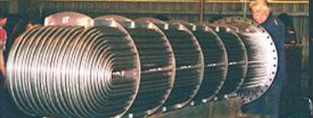
- (03) 5909 8218
- enquiry@fusionweld.com.au
Dump Condenser Tube: Definition and Applications
December 7, 2016

Little is wasted within a balanced heat exchange system. A dump process condenser adheres to the thermal mechanics of this maxim by recovering excess steam-generated heat. Fabricated as a pressure reduction stage that recovers (condenses) steam, this vessel is built to handle surplus steam loads and rescue energy from those load before they're ejected uselessly into the atmosphere.
Fabricating Surplus Solutions
When does a processing facility produce an off-balance thermal load? That's not a riddle, just a fact of heat exchange mechanics. Heat loads do produce surplus energy. A steam load fluctuates, or a turbine creates a transient pressure spike during its start cycle, or maybe the exhaust from a large boiler requires pressure reduction. Whatever the application, the vessel must be manufactured to withstand the ejected pressure and the corrosive steam. Then, as the load is ejected, the superhot airborne fluid cools and condenses, before funneling its way back into the processing stream.
How Does a Dump Condenser Tube Operate?
A shell/tube heat exchanging stack is exactingly manufactured and installed inside the tube housing. The pressurized steam is channeled into this network of tubes and cooled until the gaseous medium expands. It's this expansion effect that requires proper design scrutiny, for the expanded shape of the dump vessel is key here. Its open shaping intelligently reduces the pressure of the inlet steam channel while acting as a cooling mechanism. Of course, the aid of an expansion stage only takes thermal dynamics so far, which is why another cooling medium flows inside the tube. Separated but still able to influence the hot steam, the cold seawater or chilled air provides an active cooling mechanism, one that drastically reduces the impetus contained within the superheated steam.
Engineering the Dump Construct
Strong carbon steel plating and other corrosion-resistant steel alloys are painstakingly assembled until the vessel can be certified as steam and pressure capable. The optimized metal construct withstands intense internal pressures, obviously, but it also works unceasingly during extreme pressure spikes and very heat-corrosive instances.
As the descriptive label infers, a dump condenser is built to handle challenging upset conditions, instances when sudden steam dumps are channeled away from a smoothly operating heat exchanging process. The "dump" condition could occur in the powerplant of a marine freighter, an oil refinery heat exchanger, or even the working side of a mighty steam turbine, but the transient incident will not cause a nasty atmospheric loss, not when the condenser vessel is in place to convert the energetic exhaust back into a usable process stream.
Contact Details
Fusion - Weld Engineering Pty Ltd
ABN 98 068 987619
1865 Frankston Flinders Road,
Hastings, VIC 3915
Ph: (03) 5909 8218
Optimized by NetwizardSEO.com.au
Recent Posts
- Pressure Vessel Inspection: Maintaining Critical Water Heating Infrastructure
- Scheduling Periodic Laundry Boiler Inspections: Best Practices for Plant Managers
- Glycol Regeneration Units - Manufacturing to Optimise Natural Gas Processing
- Skid Mounted Systems for Oil and Gas Industries: Achieve Mobility and Flexibility
- The Role of Transportable Pressure Vessel Inspections in Ensuring Safety
- Periodic Tank In-Service Inspection: How It Maintains Bulk Storage Tank Integrity
- Static Pressure Vessel Manufacturing: Achieve Maximum Reliability
- Pressure Equipment Management by Fusion-Weld: Key Role in Industrial Safety
- Pressure Piping System Inspection: A Gift of Safety for the Holidays
- Deaerator Inspections by Fusion-Weld Engineering and How They Reduce System Downtime
- Bulk Storage Tank Inspection: Protecting Your Essential Assets
- Pipe Spooling Design and Manufacture: Ensuring Accuracy and Fit
Posts 2023
- Pressure Piping System Inspection: A Gift of Safety for the Holidays
- Deaerator Inspections by Fusion-Weld Engineering and How They Reduce System Downtime
- View all articles…
Posts 2022
- How Fusion Weld Keeps Up With AS-NZS ISO 9001:2008 Standard
- Boiler Equipment Safety Inspection During the Summer Season
- View all articles…
Posts 2021
- Avoid These Factors and Practices that Contribute to Sealing Damage in Pressure Vessels
- Do's And Don'ts Of Industrial Boiler Inspection And Maintenance From Fusion-Weld
- View all articles…
Posts 2020
- What are the Risks and Hazards Involved in Pressure Vessel Equipment?
- How to Know if Your Pressure Equipment Needs Repair or Replacement?
- View all articles…
Posts 2019
- Factors that Contribute to Pressure Vessel Failure
- Pressure Vessel Regulations in Australia: What are the Mandatory Requirements?
- View all articles…
Posts 2018
- Pros and Cons of Spherical vs. Cylindrical Pressure Vessels
- What are the Different Hazard Levels in Pressure Vessels?
- View all articles…
Posts 2017
- Transportable Pressure Vessels: The Importance of Inspection and Safety Checks
- Fracture Mechanics and Stress Analysis of Cracks in Pressure Vessels
- View all articles…
Posts 2016
Posts 2015
- What Are Deaerators & Feedwater Vessels?
- Precautions and Safety for Compressed Air Receiver Vessels
- View all articles…
Posts 2014
- Demonstrating In-process Inspection Procedures
- Static Grounding Practices and Standards
- View all articles…